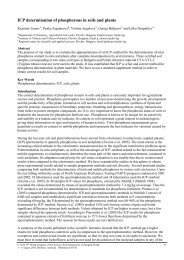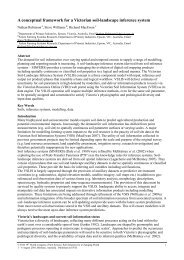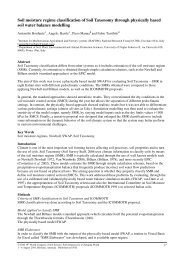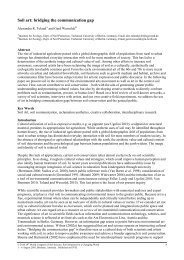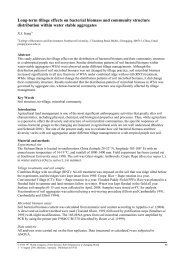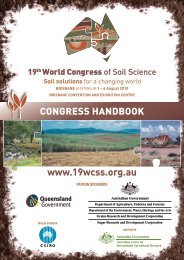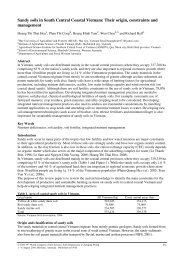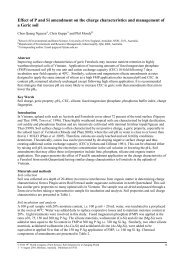Wisawapipat Worachart
Wisawapipat Worachart
Wisawapipat Worachart
You also want an ePaper? Increase the reach of your titles
YUMPU automatically turns print PDFs into web optimized ePapers that Google loves.
pH dependent charge and phosphate sorption by Thai Kandiudox<br />
<strong>Worachart</strong> <strong>Wisawapipat</strong> A , Irb Kheoruenromne A,* , Anchalee Suddhiprakarn A and Robert J. Gilkes B<br />
A Department of Soil Science, Faculty of Agriculture, Kasetsart University, Bangkok 10900, Thailand<br />
B School of Earth and Environment, Faculty of Natural and Agricultural Sciences, University of Western Australia, WA, Australia<br />
*Corresponding author. Email irbs@ku.ac.th<br />
Abstract<br />
Surface charge and phosphate sorption characteristics five Kandiudox formed on basalt under the tropical<br />
monsoonal climate in Thailand have been investigated. These soils are acidic with moderate organic matter<br />
and cation exchange capacity values and quite high amounts of microcrystalline and amorphous iron oxides.<br />
Kaolinite is the major clay mineral with moderate amounts of goethite and hematite, and minor amounts of<br />
maghemite and gibbsite. The soils have high variable charge with the magnitudes of charge and the rate of<br />
change in surface charge with pH differing between the soils. The contents of organic matter, Fe and Al<br />
organic complexes exert a strong influence on the rate of change in negative surface charge with pH (A c ).<br />
These soils have high values of phosphate sorption capacity reflecting their clayey texture, and<br />
microcrystalline and amorphous iron oxide contents. Liming of these soils will decrease Al toxicity and P<br />
fixation, and increase cation exchange capacity.<br />
Key Words<br />
Organic matter, kaolinite, microcrystalline iron oxides, variable charge, P sorption.<br />
Introduction<br />
Oxisols are variable charge soils (Qafoku et al. 2004) which are widespread in the Tropics and comprise a<br />
vital economic resource for agriculture in many countries. In Thailand, most Oxisols developed on basalt in<br />
the Southeast Coast region support tropical orchards. These soils are generally acidic and infertile with low<br />
values of cation exchange capacity. The mineralogy of the clay fraction of these soils is dominated by<br />
kaolinite and sesquioxides that exhibit variable charge on their surfaces and contribute to high P sorption<br />
capacity. To develop management approaches for efficient plant production of these soils there is a need to<br />
clarify their chemistry which includes the pH dependent surface charge and phosphate sorption<br />
characteristics.<br />
Methods<br />
Soil sampling and characterization<br />
Five profiles of Oxisols from the Southeast Coast Thailand were investigated. Pedon analysis in soil pits was<br />
carried out at each site, including detailed profile description and sampling of soil from their genetic<br />
horizons. Samples from all genetic horizons were used for determining their physicochemical properties,<br />
where samples of the prominent genetic horizons of these soils (Ap, Bt, Bto and Bo) were used for<br />
investigating their surface charge and P sorption characteristics.<br />
Bulk soil samples were air–dried and crushed to pass through a 2 mm sieve before laboratory analysis.<br />
Particle size distribution was determined by the pipette method. The specific surface area (SSA) was<br />
measured by the N 2 –BET method with a Micromeritics Gemini III 2375 surface analyzer. Soil pH was<br />
determined in water and in 1M KCl using 1:1 soil:liquid, and in 1M NaF (pH 8.0) with 1:50 soil:liquid<br />
(Fieldes and Perrott 1966). Organic carbon (OC) was determined by the Walkley and Black wet oxidation<br />
procedure (Nelson and Sommers 1996) and calculation of organic matter content (OM) in the relationship<br />
OM = OC × 1.724 was used. Cation exchange capacity (CEC) was determined by saturating the exchange<br />
sites with an index cation (NH 4 + ) using 1 N NH 4 OAc at pH 7.0. Crystalline, non crystalline, and organic<br />
forms of Fe, Al, and Mn were extracted by the specific extractants dithionite–citrate–bicarbonate solution<br />
(DCB) (Fe d , Al d , Mn d ), 0.2M ammonium oxalate solution at pH 3.0 (Fe o , Al o , Mn o ), and sodium<br />
pyrophosphate solution (Fe p , Al p , Mn p ), respectively. Dissolved Fe, Al, and Mn were measured using atomic<br />
absorption spectrophotometry.<br />
© 2010 19 th World Congress of Soil Science, Soil Solutions for a Changing World<br />
1 – 6 August 2010, Brisbane, Australia. Published on DVD.<br />
97
X–ray diffraction (XRD) analysis of the clay fraction used CuKα radiation with a Philips PW–3020<br />
diffractometer equipped with a graphite diffracted beam monochromator. Oriented clay was prepared on<br />
ceramic plates and XRD patterns obtained from 4–35° 2θ with a step size of 0.02° 2θ and a scan speed of<br />
0.04°/second after various pretreatments to aid the identification of clay minerals (Brown and Brindley<br />
1980).<br />
Surface charge and P sorption analyses<br />
Surface charge characteristics were determined by the charge fingerprint procedure described by Gillman<br />
(2007). Charge fingerprints are curves describing variations in the base cation exchange capacity (CEC B ) and<br />
anion exchange capacity (AEC) across a range of pH values.<br />
The relationships of ion adsorption capacity (CEC B , AEC) with pH were fitted to linear equation as follows:<br />
CEC B = A c pH + B c (Eq. 1)<br />
AEC = A a pH + B a (Eq. 2)<br />
where pH is the pH of the soil suspension and A c , B c , A a and B a are constants for each soil. A c and A a<br />
coefficients are the rate of change in surface charge with pH. B c and B a are constants equivalent to the<br />
magnitudes of negative and positive charge respectively at pH zero.<br />
Phosphate sorption was measured following the methodology of Singh and Gilkes (1991).<br />
P sorption data were fitted to the linear form of the Langmuir equation as follows:<br />
c/x = 1/bX m + c/X m<br />
where c is the concentration of P in equilibrium solution (µg P/mL), x is the amount of P sorbed (µg P/g<br />
soil), X m is the Langmuir sorption maximum (µg P/g soil) and b is a constant related to bonding energy<br />
(mL/µg P) (Singh and Gilkes 1991). The plot of c/x against c gives a straight line with a slope and intercept<br />
equal to 1/X m and 1/bX m , respectively.<br />
The data were also fitted to the Freundlich equation<br />
x = kc B<br />
where x is the amount of P sorbed (µg P/g soil), c is the equilibrium concentration (µg P/mL), and k and B<br />
are empirical coefficients, where k indicates the maximum sorption capacity (µg P/g soil) and B is related to<br />
bonding energy.<br />
Results<br />
Soil characteristics<br />
All soils are highly weathered Oxisols that have developed under topical monsoonal climate on colluvium<br />
and residuum derived from basalt, texture is mostly clayey throughout the profile. Clay accumulation in<br />
subsoils is present in all soils creating an argillic horizon. Oxic and kandic horizons are also present.<br />
Therefore, the soils can be classified taxonomically as Typic Kandiudox and Rhodic Kandiudox. The genetic<br />
horizons of these soils are Ap, Bt, Bto and Bo. These are very deep soils, typically acidic, well drained, with<br />
moderate to rapid permeability and moderate to slow runoff. The color of the soils varies from dusky red to<br />
dark yellowish brown which reflects iron oxide mineralogy.<br />
The pH in water of the soils indicates extremely acid to moderately acid (4.3–5.7) condition. Values of the<br />
pH in NaF solution are high (8.8–10) indicating that the soils contain mineral constituents with abundant<br />
surface OH groups (Perrott et al. 1976). Organic matter content is largest in the surface horizon and<br />
decreases systematically with depth. Values of CEC (6.4–34 cmol c /kg) and SSA (60–84 m 2 /g) are quite high<br />
as a consequence of the associated influences of organic matter contents and the small crystal size of kaolinite<br />
as indicated by weak and broad XRD reflections. Crystalline iron oxides as estimated by DCB extraction (Fe d )<br />
are the dominant form of iron oxides in these soils with amounts differing between the soils. These soils do<br />
however have elevated values of the ratio Fe o /Fe d (0.11–0.28) which are an indicative of substantial amounts of<br />
microcrystalline and amorphous iron oxides in these soils. Elevated concentrations of Fe and Al organic<br />
complexes occur in upper horizons for the Nb soils.<br />
Clay mineralogy<br />
Kaolinite is the dominant mineral of the clay fraction with moderate amounts of goethite and hematite.<br />
Various amounts of associated minerals include quartz, hydroxyl–Al interlayer vermiculite, gibbsite,<br />
maghemite and anatase. Goethite dominates over hematite which reflects the very high rainfall regime.<br />
Coherently scattering domain (CSD) sizes derived from the width at half height (WHH) of XRD reflections<br />
© 2010 19 th World Congress of Soil Science, Soil Solutions for a Changing World<br />
1 – 6 August 2010, Brisbane, Australia. Published on DVD.<br />
98
using the Scherrer equation indicate that the average size of soil kaolinite crystals is very small (9–14 nm).<br />
This may reflect relatively large content of Fe in the soil contributing to greater levels of Fe substitution for<br />
Al in soil kaolinite resulting in a smaller crystal size (Hart et al. 2003).<br />
Surface charge characteristics<br />
All soils reveal strong variable charge behavior with the magnitudes of negative and positive charges and the<br />
rate of change in surface charge with pH differing between the soils (Figure 1). Magnitudes of both negative<br />
and positive charges for these Kandiudox are relatively large which is presumably due to their more clayey<br />
texture and larger contents of sesquioxides. Surface horizons have greater negative variable charges than do<br />
subsurface horizons due to their greater contents of organic matter. The contents of organic matter, and Fe<br />
and Al organic complexes (Al p , Fe p ) have a strong effect on the rate of change in negative surface charge with<br />
pH (A c ) (Figure 2). The soils contain abundant sesquioxides, mostly goethite with hematite and traces of<br />
gibbsite and maghemite which variously contribute to the positive surface charge. Appreciable amounts of<br />
noncrystalline iron and aluminum oxides as indicated by oxalate extractable Fe and Al are present in these<br />
soils and will contribute substantially to positive surface charge (Sposito 1989).<br />
10<br />
CEC Ti3_Ap<br />
CEC Ti3_Bo1<br />
(a)<br />
10<br />
CEC Nb2_Ap<br />
CEC Nb2_Bt3<br />
(b)<br />
CEC Ti3_Bto1<br />
CEC Nb2_Bto1<br />
AEC Ti3_Ap<br />
AEC Nb2_Ap<br />
CECB and AEC (cmolc/kg)<br />
5<br />
0<br />
AEC Ti3_Bo1<br />
AEC Ti3_Bto1<br />
CEC<br />
CECB and AEC (cmolc/kg)<br />
pH<br />
5<br />
0<br />
AEC Nb2_Bt3<br />
AEC Nb2_Bto1<br />
CEC<br />
pH<br />
AEC<br />
-5<br />
3.0 3.5 4.0 4.5 5.0 5.5 6.0 6.5 7.0 7.5 8.0<br />
AEC<br />
-5<br />
3.0 3.5 4.0 4.5 5.0 5.5 6.0 6.5 7.0 7.5 8.0<br />
Figure 1. Charge fingerprints for surface and subsurface horizons of whole soil samples for Ti3(a) and Nb2(b)<br />
Thai Kandiudox.<br />
Ac (cmol c/kg/pH)<br />
4<br />
3<br />
2<br />
1<br />
y = 0.024x + 1.42<br />
R 2 = 0.76<br />
4<br />
3<br />
2<br />
1<br />
y = 0.11x + 1.29<br />
R 2 = 0.67<br />
4<br />
3<br />
2<br />
1<br />
y = 0.17x + 1.44<br />
R 2 = 0.61<br />
0<br />
0 20 40 60 80<br />
OM (g/kg)<br />
0<br />
0 5 10 15 20<br />
Al p (g/kg)<br />
0<br />
0 3 6 9 12<br />
Fe p (g/kg)<br />
Figure 2. Significant relationships of the charge coefficient (A c ) with OM, Al p and Fe p for Thai Kandiudox.<br />
Phosphate sorption characteristics<br />
The P sorption data are well described by both Langmuir and the Freundlich equations (mean R 2 = 0.98 and<br />
0.96, respectively). The good fit of both equations to the data is partly due to the limited range of equilibrium<br />
concentrations which are generally lower than 1 µg/mL so that other P-Retention/precipitation processes do<br />
not occur (Barrow 2006). The coefficient of determination (R 2 ) for the Langmuir equation is slightly higher<br />
than for the Freundlich equation which is consistent with the finding of Siradz (2000) and Hartono et al.<br />
(2005) for Indonesian soils. Values of Langmuir P sorption maximum (X m ) for these soils range from 833 to<br />
1250 µg/g, while the Freundlich coefficient (k) which is also a measure of the abundance of P sorption sites<br />
in a soil ranges from 521 to 1694 µg/g. The considerable values of P sorption capacity for these soils reflect<br />
© 2010 19 th World Congress of Soil Science, Soil Solutions for a Changing World<br />
1 – 6 August 2010, Brisbane, Australia. Published on DVD.<br />
99
the heavy texture and sesquioxidic mineralogy which provide abundant adsorption sites. Iron oxides are<br />
responsible for most of the P sorption by the clay fraction (Fontes and Weed 1996).<br />
Management approaches<br />
This result suggests that these soils could be ameliorated by conventional agricultural practices such as<br />
surface organic matter management and additions of fertilizer and liming application. Liming decreases<br />
aluminum toxicity and increases the abundance of negatively charge sites in soils that contain variable<br />
charge constituents. Surface organic matter management can also increase a number of available sites for<br />
negative variable charge and can restrain P fixation by sesquioxides due to the formation of Fe and Al oxide<br />
complexes.<br />
Conclusions<br />
Kaolinite and iron oxides are major soil constituents and the small crystal sizes of these soil kaolinite and<br />
microcrystalline iron oxides may exerts a substantial influence on charge properties and variously contribute<br />
to their fertility. These soils show strong variable charge behavior and high P sorption capacity.<br />
Acknowledgments<br />
The authors are grateful to The Royal Golden Jubilee Ph.D. Program under the Thailand Research Fund for<br />
financial support and to the laboratory staff at the School of Earth and Environment, UWA, particularly Mr.<br />
Michael Smirk for assistance with chemical analysis.<br />
References<br />
Barrow NJ (2006) A mechanistic model for describing the sorption and desorption of phosphate by soil.<br />
European Journal of Soil Science 34, 733–750.<br />
Brown G, Brindley GW (1980) X–ray diffraction procedures for clay mineral identification. In ‘Crystal<br />
Structures of Clay Minerals and Their X–ray Identification’. (Eds GW Brindley, G Brown) pp. 305–359.<br />
(Spottiswoode Blallantyne Ltd.: London)<br />
Fontes MPF, Weed SB (1996) Phosphate adsorption by clays from Brazilian Oxisols: relationships with<br />
specific surface area and mineralogy. Geoderma 72, 37–51.<br />
Gillman GP (2007) An analytical tool for understanding the properties and behaviour of variable charge<br />
soils. Australian Journal of Soil Research 45, 83–90.<br />
Hart RD, Wiriyakitnateekul W, Gilkes RJ (2003) Properties of soil kaolins from Thailand. Clay Minerals 38,<br />
71–94.<br />
Hartono A, Funakawa S, Kosak T (2005) Phosphorus sorption–desorption characteristics of selected acid<br />
upland soils in Indonesia. Soil Sci. Plant Nutr. 51, 787–799.<br />
Qafoku NP, Van Ranst E, Noble A, Baert G (2004) Variable charge soils: Their mineralogy, chemistry and<br />
management. Advances in Agronomy 84, 159–215.<br />
Singh B, Gilkes RJ (1991) Phosphorus sorption in relation to soil properties for the major soils types of<br />
South–Western Australia. Australian Journal of Soil Research 29, 603–618.<br />
Siradz S (2000) Mineralogy and Chemistry of Red Soils of Indonesia. Ph.D. Thesis, The University of<br />
Western Australia, Perth.<br />
Sposito G (1989) ‘The Chemistry of Soils.’ (Oxford University Press: New York)<br />
© 2010 19 th World Congress of Soil Science, Soil Solutions for a Changing World<br />
1 – 6 August 2010, Brisbane, Australia. Published on DVD.<br />
100



